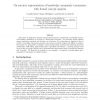Free Online Productivity Tools
i2Speak
i2Symbol
i2OCR
iTex2Img
iWeb2Print
iWeb2Shot
i2Type
iPdf2Split
iPdf2Merge
i2Bopomofo
i2Arabic
i2Style
i2Image
i2PDF
iLatex2Rtf
Sci2ools
IJFCS
2008
2008
On Succinct Representation of Knowledge Community Taxonomies with Formal Concept Analysis
We present an application of formal concept analysis aimed at representing a meaningful structure of knowledge communities in the form of a lattice-based taxonomy. The taxonomy groups together agents (community members) who develop a set of notions. If no constraints are imposed on how it is built, a knowledge community taxonomy may become extremely complex and difficult to analyze. We consider two approaches to building a concise representation respecting the underlying structural relationships, while hiding uninteresting and/or superfluous information: a pruning strategy based on the notion of concept stability and a representational improvement based on nested line diagrams and "zooming". We illustrate the methods on two examples: a community of embryologists and a community of researchers in complex systems.
| Added | 12 Dec 2010 |
| Updated | 12 Dec 2010 |
| Type | Journal |
| Year | 2008 |
| Where | IJFCS |
| Authors | Camille Roth, Sergei A. Obiedkov, Derrick G. Kourie |
Comments (0)

